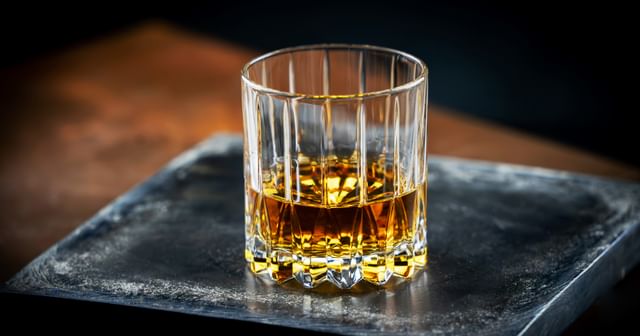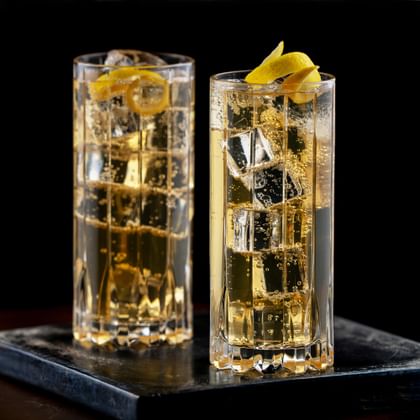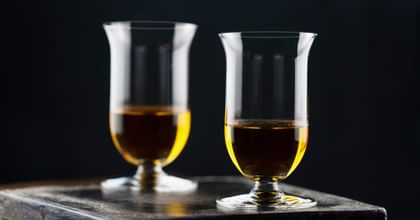What the bartender says
Whisky

Get ready to take your whisky know-how and enjoyment to new levels as we cover different ways of serving whisky, the various styles to consider and their characteristics, and which glassware to use to help you get the most out of your whisky enjoyment.
Styles, serving, and function-specific glassware
When it comes to beverage variety, there's not much whisky can't do. This heralded dark spirit can be enjoyed neat, with water or ice, or in a range of cocktails. Not only that, whisky comes in all sorts of styles and can be enjoyed from numerous glasses - each of which best suits a particular serving style.

Ways to serve your whisky
Neat
Sometimes, whisky is best enjoyed in its most simple form. This serving style is typically best for whiskies with complex aromas and flavors for you to examine and appreciate. When enjoying a quality whisky served neat, take a moment to inhale its scent, allowing your senses to observe its characteristics in detail before mindfully sipping and savoring the taste.
Ways to serve your whisky
With water or ice
Serving your whisky with a splash of water or with some ice can alter your drink in a few ways:
- Adding water reduces the intensity of whisky by diluting the alcohol while still allowing you to enjoy its aromas. Water can also release and develop aroma compounds in the whisky, helping its qualities to evolve.
- Chilling your whisky by serving it over ice blunts its harshness, making it easier to sip for some. Doing this can also dull some of its flavor and aromas, but its refreshing effect on your whisky makes it ideal for some.
- Ice also melts in your whisky over time, gradually diluting it and changing your experience of the whisky as you sip.

Ways to serve your whisky
In a cocktail
Whisky is used in some of the world's best-loved classic cocktails, including the old fashioned, Manhattan, whiskey sour, and more. Classic whisky cocktails became popular in the early to mid-20th century before taking a backseat in the mid-to-late-20th century as tiki cocktails and disco drinks took center stage. However, from the 1990s onward, classic cocktails came back in a big way, which was good news for all of the famous whisky-based classics, which have remained popular to this day.
What the bartender says
Types of whisky to choose from
Due to its global popularity, there are quite a few types of whisky that you may consider trying. Each style has its own qualities and can be enjoyed differently. Choosing which is best for you is simply a matter of determining which style best suits your preferences and the drinking styles you lean toward. Here are some of the world's best-known whisky styles for you to consider.
Types of whisky to choose from
Bourbon whiskey
Bourbon prevails as the most popular style in the United States, first emerging in Kentucky in the 19th century and being named after the French Bourbon dynasty.
Bourbon's use of at least 51% corn in the mash bill gives it a smooth and slightly sweet flavor profile, while barrel aging imparts flavors such as caramel, toffee, and vanilla into many bourbons. Some other notes bourbon can exhibit include smoke, apple, and spices like pepper or cinnamon—although spice notes are more commonly associated with another American whiskey that we'll discuss later.
When it comes to ways of drinking it, bourbon is famously versatile. It is commonly enjoyed neat, with ice, or in cocktails. Bourbon whiskey is often used as the base spirit for several classic cocktails, such as the old fashioned or the whiskey sour. So, if drinks like those are to your liking, then bourbon might be your ideal whiskey.
Types of whisky to choose from
Rye whiskey
Rye whiskey is made in much the same way as bourbon but with rye as its primary grain instead of corn. Rye whiskey was actually the first style to emerge in the US, becoming prominent in northeastern US states in the late 18th and 19th centuries before declining in popularity during the 1900s. Don't confuse rye whiskey with Canadian rye whisky, though; any whisky produced in Canada can be given the latter label, including those not made with rye.
Due to being made with at least 51% rye in the mashing bill, rye whiskey typically exhibits a distinct spicy flavor profile. Spices often identified in rye whiskies include black pepper, cinnamon, cloves, and other baking spices, giving the whiskey style a bold and assertive character.
Many popular whiskey cocktails that may today be associated with bourbon can be made with rye instead, which is helpful to know if you prefer cocktails with a slightly spicier profile. In fact, many popular whiskey cocktails, such as the old fashioned and the Manhatten, were initially made with rye whiskey, with bourbon only becoming more commonly used when it began to overtake rye whiskey in popularity.
Different RIEDEL Glasses
Choosing the right glass
If you prefer to sip your whisky neat or with a bit of water, the ideal glass is one that allows you to examine and appreciate the whisky's aromas. The RIEDEL Vinum Single Malt Whisky achieves this with its narrow bowl, which helps to contain the whisky's aromas, while its outward-curving lip then delivers the whisky seamlessly to your palate. This glass is also designed with a truncated stem, allowing you to slightly warm the glass in your hand, enhancing your whisky's aromas and flavors for a more enjoyable experience.
If enjoying ice with your whisky is more your thing, consider opting for a rocks glass. The RIEDEL Drink Specific Glassware Rocks Glass and RIEDEL Drink Specific Glassware Double Rocks Glass are designed to accommodate large format ice, allowing you to chill your whisky. If you'd prefer to swap between enjoying your whisky over ice sometimes and having it neat or with water sometimes, consider using our RIEDEL Drink Specific Glassware Neat Glass, which also accommodates large format ice without dominating whisky poured neat.
Lovers of whisky-based cocktails have a few options to consider:
- Spirit-forward whisky-based cocktails served with ice, such as a classic old fashioned, are best enjoyed from a rocks/old fashioned glass. Our RIEDEL Drink Specific Glassware Rocks Glass has the perfect dimensions to accommodate these drinks, keeping them well chilled for your enjoyment.
- Whisky-based cocktails that use a higher volume of mixer, such as how Japanese whisky is often drunk, are typically enjoyed from a highball/long drink glass. The RIEDEL Drink Specific Glassware Highball Glass provides the appropriate height and capacity for optimal enjoyment of these cocktails while still having the width to accommodate large format ice.
- One of the most popular sour cocktails around is the whiskey sour. If this is a favorite of yours, consider our RIEDEL Drink Specific Glassware Sour Glass, which is designed with an outward-flared lip to deliver the silky smoothness of this cocktail to your entire palate.
- For spirit-forward whisky-based cocktails that are shaken or stirred with ice but served without, the RIEDEL Drink Specific Glassware Nick & Nora Glass does just the trick. This glass is designed to provide ultimate ease when sipping and is well-suited to cocktails you may associate with a Martini or Coupe glass. You can learn more about this glass in our Nick & Nora blog.
As with any other cocktail, the best glass for various whisky-based cocktails depends on the overall size, components, and characteristics of the cocktail, as well as how it is mixed and whether it is served over ice. The glasses listed above are just a few glassware suggestions that accommodate some popular whisky-based cocktails; visit our RIEDEL Drink Specific Glassware Collection page for a full overview of this cocktail-specific glassware series.
We hope that serves as a helpful overview if you're at the beginning of your whisky journey, considering what types of whisky to explore, or wondering what glasses to sip your whisky from. Once you've identified the whisky you want, how you'll drink it, and the glass you'll use, all that's left to do is to open that bottle and enjoy!
Locations


